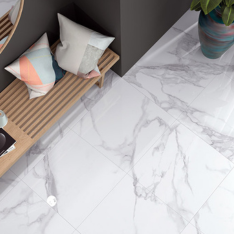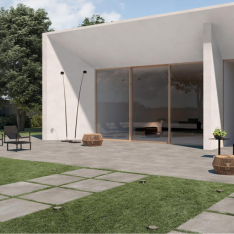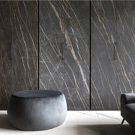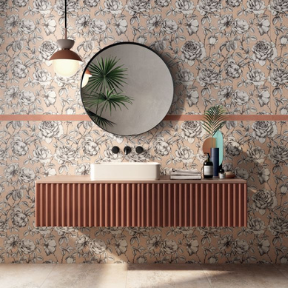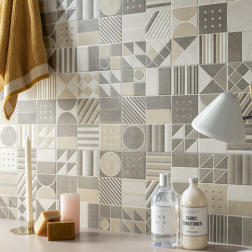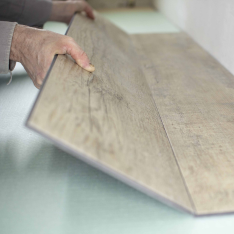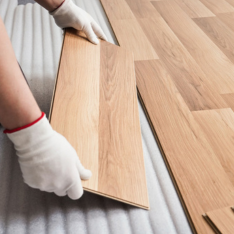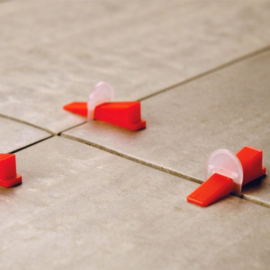Choosing the right floor for your home is a fundamental decision that affects not only the aesthetics of the rooms but also their functionality and comfort. The floor represents one of the most visible and permanent elements within a home, and its choice must be made carefully, considering various aspects.
In this article, we will analyze various materials, styles, and finishes, providing a complete guide to help you navigate the world of flooring. From color psychology to current design trends, each section will offer useful insights to guide you in choosing the ideal floor for your home.
The importance of choosing the right floor for your home
Choosing the floor is not just an aesthetic issue; it has a significant impact on the quality of life inside your home. A well-chosen floor can improve lighting, the perception of space, and even thermal comfort. For example, light colors can make a room seem larger and brighter, while dark colors can lend warmth and intimacy.
Furthermore, the floor affects the maintenance and durability of domestic environments. Some materials require more frequent care and cleaning, while others can better withstand wear and scratches. Considering your daily habits and the number of people living in the house, you can choose a material that lasts over time and suits your lifestyle.
Finally, the floor can also influence the value of your property. Investing in a high-quality, well-designed floor can increase your home's appeal on the real estate market. Buyers often pay attention to these details, so a thoughtful choice can also be advantageous from an economic perspective.
Choosing the ideal floor: pros and cons of the main materials
When it comes to flooring materials, the options are numerous and varied. Here is an overview of the most common materials, with their respective pros and cons.
1. Parquet
- Pros. It is elegant and provides a warm and welcoming look. It is also durable and can be sanded and refinished to remove scratches or signs of wear.
- Cons. It requires regular maintenance and can be affected by humidity, leading to the risk of warping or swelling.

2. Laminate
- Pros. It is economical and easy to install. Scratch-resistant and available in a wide range of styles and colors.
- Cons. It cannot be sanded and, once damaged, is difficult to repair. It doesn't have the warmth and elegance of solid wood.
3. Porcelain Stoneware
- Pros. Extremely durable and moisture-resistant, available in many effects, finishes, and colors. Ideal for all rooms in the house.
- Cons. Can be cold to the touch and hard.

4. Vinyl
- Pros. Very versatile, waterproof, and available in a variety of designs that mimic other materials. Easy to clean and maintain.
- Cons. Can wear out over time and does not have the same longevity as other materials.
5. Natural Stone
- Pros. Aesthetically pleasing and unique, offers excellent durability and a sense of luxury. It is perfect for indoor and outdoor spaces.
- Cons. Can be expensive and requires regular sealing to prevent stains and damage.
6. SPC
- Pros. SPC flooring offers strength and durability, is waterproof, does not warp, is easy to clean, has easy installation, and provides good sound insulation. They are available in a wide aesthetic choice.
- Cons. SPC floors generally cost slightly more than other types of vinyl flooring. Additionally, they are sensitive to temperature fluctuations.
Choosing the floor: effects and styles
Choosing the style of the floor is fundamental to defining the overall look of your home. Effects and styles can vary enormously and influence the atmosphere of the rooms.
Classic Style. Wood or marble are often associated with a classic and timeless design. These materials can be paired with elegant rugs and antique furniture to create a refined environment. If you desire a traditional look, opt for warm tones and natural textures.
Modern Style. For a contemporary atmosphere, consider concrete or metal effects. These materials can add an innovative touch.
Rustic Style. If you love the feeling of warmth and welcome, wood and stone can fit perfectly. Aged effects or matte finishes contribute to a rustic and natural atmosphere. You can complete the look with solid wood accessories and natural fabrics.
Color psychology applied to floors
Colors have a significant impact on the mood and emotion of a space. When choosing flooring, color psychology plays a crucial role. Here are some common colors and their effects:
Choosing the floor: neutral colors
Neutral colors like beige, gray, and white create a calm and relaxing atmosphere. This type of flooring is versatile and adapts to any decor style, making it easier to match with other decorative elements.
Choosing the floor: warm colors
Tones like red, orange, and yellow can make a space more welcoming and lively. These colors are ideal for social environments such as living rooms and kitchens, where you want to encourage interaction and conviviality.
Choosing the floor: cool colors
Blue, green, and purple can create a calm and relaxing atmosphere, perfect for bedrooms and bathrooms. These colors can also make a space seem larger and more airy, making them an excellent choice for small rooms.
Choosing the floor: glossy, matte, or satin finish?
The finish of the floor is another crucial aspect in choosing the right material. Finishes can influence not only the aesthetics but also the functionality and maintenance of the floor.
Glossy Finish. Glossy finishes reflect light, creating a bright and spacious effect. They are particularly suitable for modern environments and can be easier to clean. However, they tend to show scratches and footprints, requiring more careful maintenance.
Matte Finish. Matte finishes offer a more natural and warm look, ideal for rustic or classic environments. They hide scratches and imperfections better but may require more attention during cleaning, as they tend to retain dust.
Satin Finish. The satin finish represents a balance between glossy and matte. It offers an elegant look without the excessive reflection of a glossy finish, making it a versatile choice for various decor styles. It is also resistant to scratches and stains, making it practical for high-traffic areas.

How to choose the floor: factors to consider
When deciding which floor to choose, there are several factors to consider. It is essential to evaluate your needs and the characteristics of the environment.
1. Use of the Room
Consider how the space will be used. If you have children or pets, resistant and easy-to-clean materials like porcelain stoneware or vinyl might be ideal. Conversely, for a bedroom, you might prefer a parquet floor for its warmth and comfort.
2. Budget
Setting a budget is essential. Some materials, like natural stone, can be expensive both to purchase and install. Also, consider long-term maintenance costs, as some floors require more attention and care than others.
3. Comfort
Comfort is an element not to be underestimated. Some materials, like wood or vinyl, can feel more pleasant to the touch than porcelain stoneware tiles, especially during colder months. Additionally, consider the acoustic and thermal insulation offered by the chosen material.
Floors for every room in the house
Each room in the house has specific flooring needs. Here are some recommendations on how to choose the floor for various spaces.
Living Room
- Recommended Material. Parquet or laminate for a cozy atmosphere.
- Finish. Satin for a balance between glossy and matte.
- Color. Warm or neutral tones to harmonize with the decor.
Kitchen
- Recommended Material. Porcelain stoneware tiles or vinyl for their moisture resistance.
- Finish. Glossy for easy cleaning.
- Color. Light tones to reflect light and make the space feel airier.
Bathroom
- Recommended Material. Porcelain stoneware tiles or natural stone for their impermeability.
- Finish. Matte for an elegant and non-slip look.
- Color. Fresh and relaxing tones for a spa-like environment.
Bedroom
- Recommended Material. Parquet or carpet for a feeling of warmth and comfort.
- Finish. Matte or satin for a tranquil atmosphere.
- Color. Soft and relaxing tones to promote rest.
Office
- Recommended Material. Porcelain stoneware, laminate, or vinyl for their durability.
- Finish. Satin for a professional look.
- Color. Neutral or dark tones for a serious and focused atmosphere.
Current trends in floor design
Floor design is constantly evolving, with new trends emerging regularly. Here are some of the current trends that might inspire you in choosing your floor.
1. Narrow Plank Wood Flooring
Narrow plank wood flooring, using smaller and shorter boards, is gaining popularity for its more modern and versatile look. They offer a greater variety of styles and can adapt to smaller spaces.
2. Large Tiles
Large-format tiles are becoming increasingly common as they create a more uniform look and require fewer grout lines.
3. Natural Texture
Materials that mimic natural textures, such as wood and stone, are increasingly in demand. These materials offer an organic and warm appearance, helping to create a cozy home environment.
4. Bold Decorations
The use of floral or geometric decorations is becoming a popular choice for adding personality to spaces. However, it is important to balance these patterns with neutral colors to avoid an overly chaotic look.
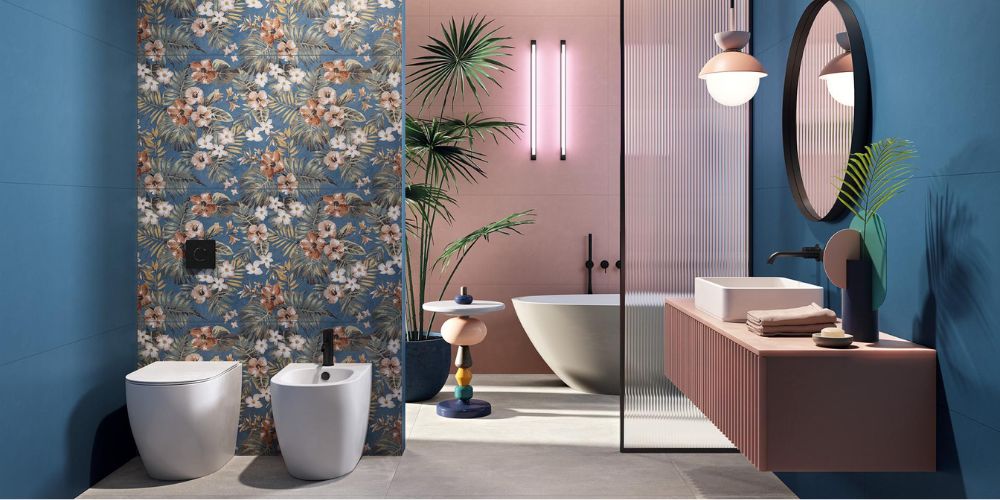
Conclusion: choosing the perfect floor for your lifestyle
Choosing the right floor for your home is a decision that deserves attention and care. By considering materials, colors, finishes, and current trends, you can create a space that not only meets your aesthetic needs but is also functional and durable over time.
Remember to consider your lifestyle and the practical needs of your family in your choice. With an informed approach and a clear vision, you will be able to choose the perfect floor for your home, one that reflects your personality and contributes to daily comfort.


